A Downhole Hydrocyclone for the Recovery of Natural Gas Hydrates and Desanding: The CFD Simulation of the Flow Field and Separation Performance
Abstract
:1. Introduction
2. Numerical Method
2.1. Structure Geometry
2.2. Model Description
2.3. Simulation Conditions and Boundary Condition
3. Results and Discussion
3.1. The Model Validation
3.2. Flow Field Characteristics
3.2.1. Turbulence Intensity
3.2.2. Static Pressure
3.2.3. Tangential Velocity
3.2.4. Axial Velocity
3.2.5. Radial Velocity
3.3. Separation Performance
3.3.1. Solid Volume Fraction Distribution
3.3.2. Separation Efficiency
4. Conclusions
- (1)
- The distributions of static pressure, tangential velocity, axial velocity and radial velocity in the NGH hydrocyclone are the same as those in traditional hydrocyclones. However, unlike in the traditional hydrocyclone, the turbulence is more intense, and the larger value appears in the middle of the cone section in NGH hydrocyclone. Further, it is found that the short circuit flow contributed to the recovery of NGH.
- (2)
- To balance the two objectives of NGH recovery efficiency and sand removal efficiency, it is suggested that the the static pressure, and tangential velocity are controlled reasonably to govern NGH and sand particle movement. In addition, it is suggested that the axial velocity is used to control the split ratio of upward and downward flow.
- (3)
- With the increase in particle diameter and inlet velocity, the volume fraction of the NGH solid near the center of the hydrocyclone increases, and the volume fraction of the sand solid near the wall of hydrocyclone increases. The separation efficiency increases first and is then stable. Furthermore, most separation efficiencies were over 80%, and the differential pressure was less than 0.6 MPa. Overall, the results show that this NGH hydrocyclone can balance the two objectives of NGH recovery efficiency and sand removal efficiency and have good separation performance for NGH separation. The separation efficiency can be improved by changing the inlet velocity.
- (4)
- In this paper, the effects of phase change and particle shape on the NGH separation process are not considered. However, research on these effects is significant, and will be carried out in the later research.
Author Contributions
Funding
Acknowledgments
Conflicts of Interest
References
- Kezirian, M.T.; Phoenix, S.L. Natural Gas Hydrate as a Storage Mechanism for Safe, Sustainable and Economical Production from Offshore Petroleum Reserves. Energies 2017, 10, 828. [Google Scholar] [CrossRef]
- Boswell, R.; Collett, T.S. Current perspectives on gas hydrate resources. Energy Environ. Sci. 2011, 4, 1206–1215. [Google Scholar] [CrossRef]
- Collett, T.S.; Johnson, A.H.; Knapp, C.C.; Boswell, R. Natural gas hydrates—A review. Browse Collect. 2009, 89, 146–219. [Google Scholar]
- Masui, A.; Haneda, H.; Ogata, Y.; Aoki, K. Mechanical Properties of Sandy Sediment Containing Marine Gas Hydrates In Deep Sea Offshore Japan. In Proceedings of the Seventh ISOPE Ocean Mining Symposium, Lisbon, Portugal, 1–6 July 2007; International Society of Offshore and Polar Engineers (SPE): Richardson, TX, USA, 2007; p. 4. [Google Scholar]
- Chong, Z.R.; Yang, S.H.B.; Babu, P.; Linga, P.; Li, X.S. Review of natural gas hydrates as an energy resource: Prospects and challenges. Appl. Energy 2016, 162, 1633–1652. [Google Scholar] [CrossRef]
- Zhang, W.; Shao, M.J.; Tian, Q.L. Technical Progress of a Pilot Project to Produce Natural Gas Hydrate in Japanese Waters. Pet. Drill. Tech. 2017, 45, 101–105. [Google Scholar]
- Lu, J.; Xiong, Y.; Li, D.; Shen, X.; Wu, Q.; Liang, D. Experimental Investigation of Characteristics of Sand Production in Wellbore during Hydrate Exploitation by the Depressurization Method. Energies 2018, 11, 1673. [Google Scholar] [CrossRef]
- Feng, J.C.; Wang, Y.; Li, X.S. Entropy generation analysis of hydrate dissociation by depressurization with horizontal well in different scales of hydrate reservoirs. Energy 2017, 125, 62–71. [Google Scholar] [CrossRef]
- Zhou, S.W.; Chen, W.; Li, Q.P.; Zhou, J.L.; Shi, H.S. Research on the solid fluidization well testing and production for shallow non-diagenetic natural gas hydrate in deep water area. Offshore Oil Gas China 2017, 29, 1. [Google Scholar]
- Zhou, S.; Zhao, J.; Li, Q.; Chen, W.; Zhou, J.; Wei, N.; Sun, W. Optimal Design of the Engineering Parameters for the first Global Trial Production of Marine Natural Gas Hydrates through Solid Fluidization. Nat. Gas Ind. 2018, 5, 118–131. [Google Scholar] [CrossRef]
- Qiu, S.Z.; Wang, G.R.; Zhou, S.W.; Liu, Q.Y.; Zhong, L.; Wang, L.Z. The downhole hydrocyclone separator for purifying natural gas hydrate: Structure design, optimization, and performance. Sep. Sci. Technol. 2019, 1–11. [Google Scholar] [CrossRef]
- Bu, X.N.; Zhang, T.T.; Peng, Y.L.; Xie, G.Y.; Wu, E.D. Multi-Stage Flotation for the Removal of Ash from Fine Graphite Using Mechanical and Centrifugal Forces. Minerals 2018, 1, 15. [Google Scholar] [CrossRef]
- Ni, L.; Tian, J.; Song, T.; Jong, Y.; Zhao, J. Optimizing Geometric Parameters in Hydrocyclones for Enhanced Separations: A Review and Perspective. Sep. Purif. Rev. 2019, 48, 30–51. [Google Scholar] [CrossRef]
- Liu, Y.; Cheng, Q.; Zhang, B.; Tian, F. Three-phase hydrocyclone separator—A review. Chem. Eng. Res. Des. 2015, 100, 554–560. [Google Scholar] [CrossRef]
- Wang, H.; Zhang, Y.; Wang, J. Cyclonic Separation Technology: Researches and Developments. Chin. J. Chem. Eng. 2012, 20, 212–219. [Google Scholar] [CrossRef]
- Jiang, L.; Liu, P.; Zhang, Y.; Yang, X.; Wang, H. The Effect of Inlet Velocity on the Separation, Performance of a Two-Stage Hydrocyclone. Minerals 2019, 9, 209. [Google Scholar] [CrossRef]
- Liow, J.L.; Oakman, O.A. Performance of mini-axial hydrocyclones. Miner. Eng. 2018, 122, 67–78. [Google Scholar] [CrossRef]
- Zhu, G.; Liow, J.L.; Neely, A. Computational study of the flow characteristics and separation efficiency in a mini-hydrocyclone. Chem. Eng. Res. Des. 2012, 90, 2135–2147. [Google Scholar] [CrossRef]
- Zhao, Q.; Cui, B.; Wei, D.; Song, T.; Feng, Y. Numerical analysis of the flow field and separation performance in hydrocyclones with different vortex finder wall thickness. Powder. Technol. 2019, 345, 478–491. [Google Scholar] [CrossRef]
- Shi, S.Y.; Xu, J.Y. Flow field of continuous phase in a vane-type pipe oil–water separator. Exp. Therm. Fluid Sci. 2015, 60, 208–212. [Google Scholar] [CrossRef]
- Evans, W.K.; Suksangpanomrung, A.; Nowakowski, A.F. The simulation of the flow within a hydrocyclone operating with an air core and with an inserted metal rod. Chem. Eng. J. 2008, 143, 51–61. [Google Scholar] [CrossRef]
- Ghodrat, M.; Kuang, S.B.; Yu, A.B.; Vince, A.; Barnett, G.D.; Barnett, P.J. Numerical analysis of hydrocyclones with different vortex finder configurations. Miner. Eng. 2014, 63, 125–138. [Google Scholar] [CrossRef]
- Kuang, S.B.; Chu, K.W.; Yu, A.B.; Vince, A. Numerical study of liquid–gas–solid flow in classifying hydrocyclones: Effect of feed solids concentration. Miner. Eng. 2012, 31, 17–31. [Google Scholar] [CrossRef]
- Wang, B.; Chu, K.W.; Yu, A.B.; Vince, A.; Barnett, G.D.; Barnett, P.J. Computational study of the multiphase flow and performance of dense medium cyclones: Effect of body dimensions. Miner. Eng. 2011, 24, 19–34. [Google Scholar] [CrossRef]
- Hsieh, K.T.; Rajamani, K. Phenomenological model of hydrocyclone: Model development and verification for single-phase flow. Int. J. Miner. Process. 1988, 22, 223–237. [Google Scholar] [CrossRef]
- Delgadillo, J.A. Modelling of 75- and 250-mm Hydrocyclones and Exploration of Novel Designs Using Computational Fluid Dynamics. Ph.D. Thesis, University of Utah, Salt Lake City, UT, USA, 2006. [Google Scholar]
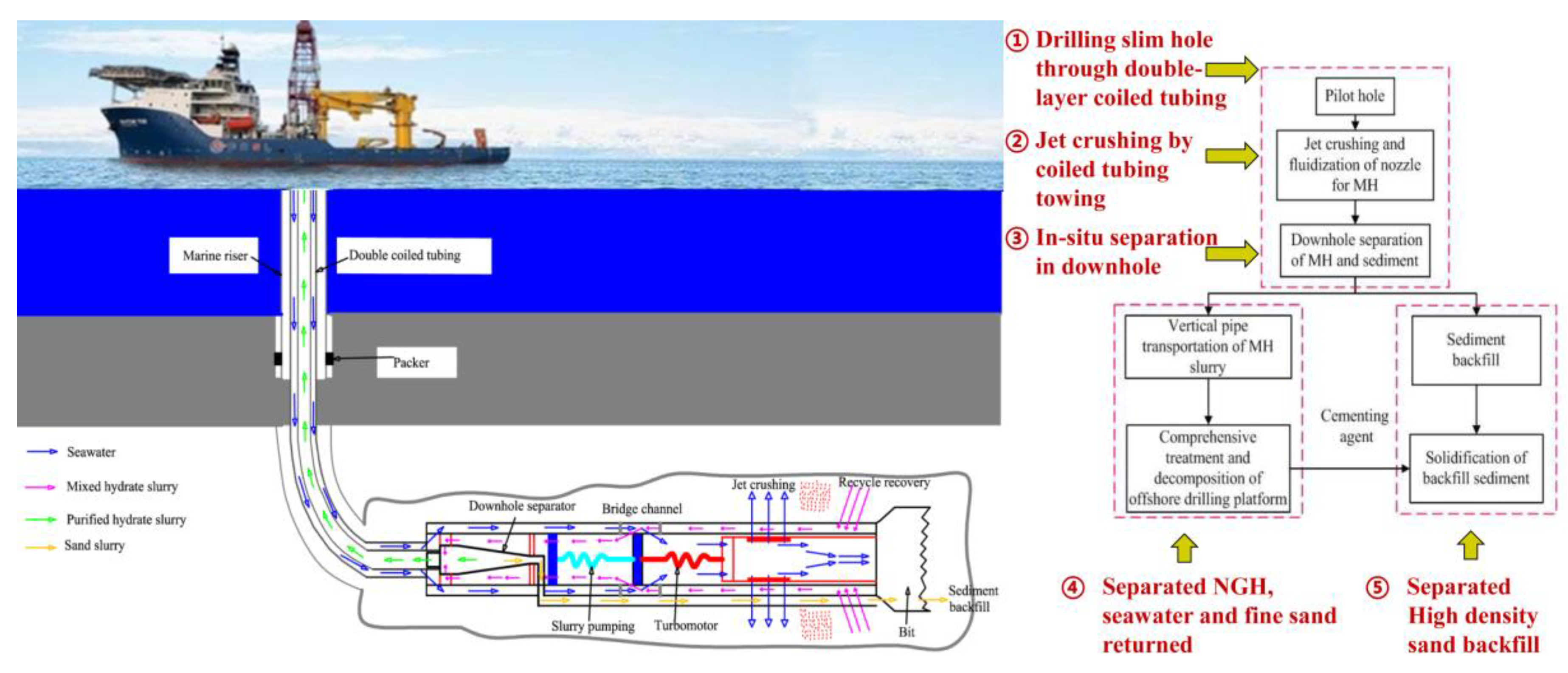

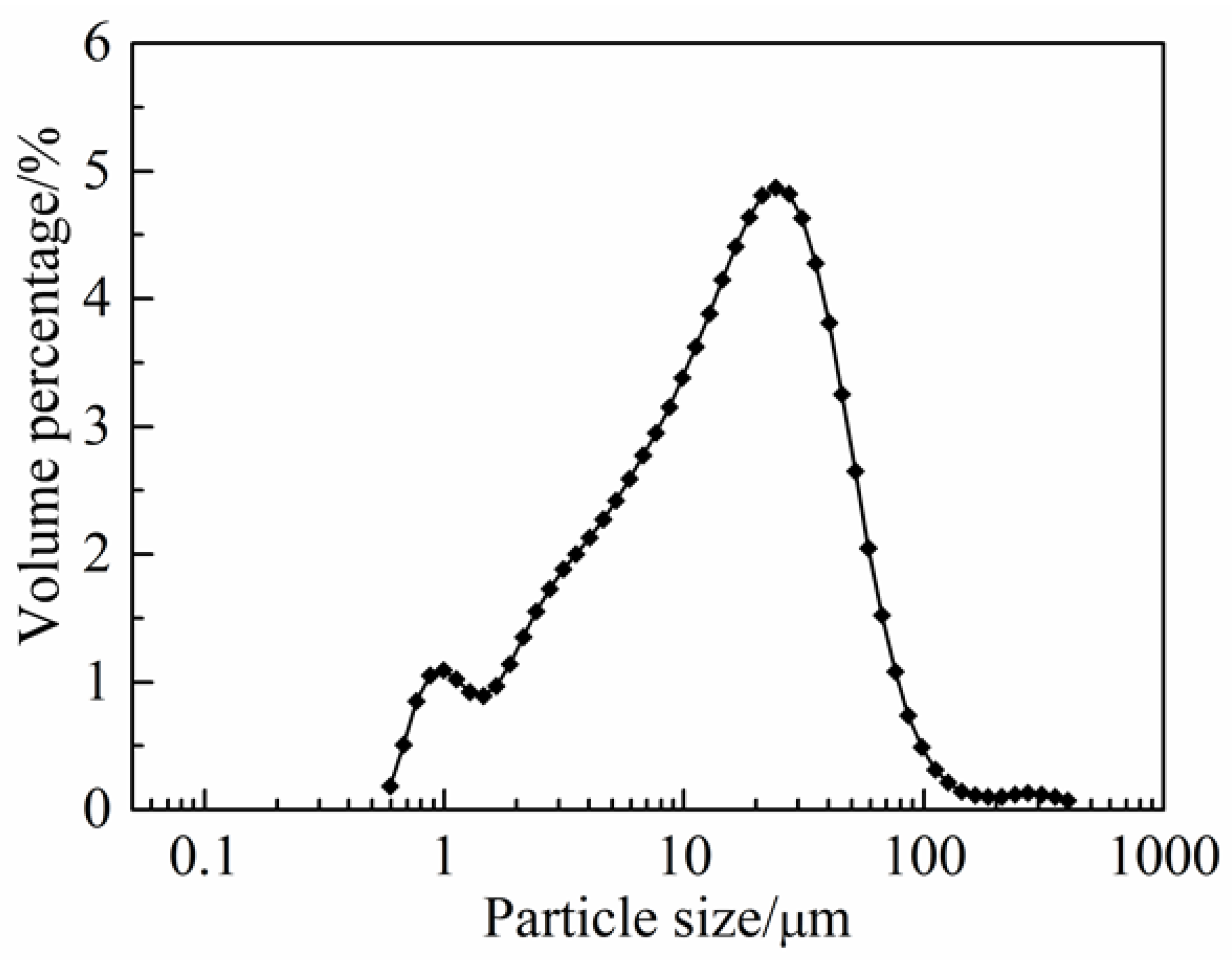



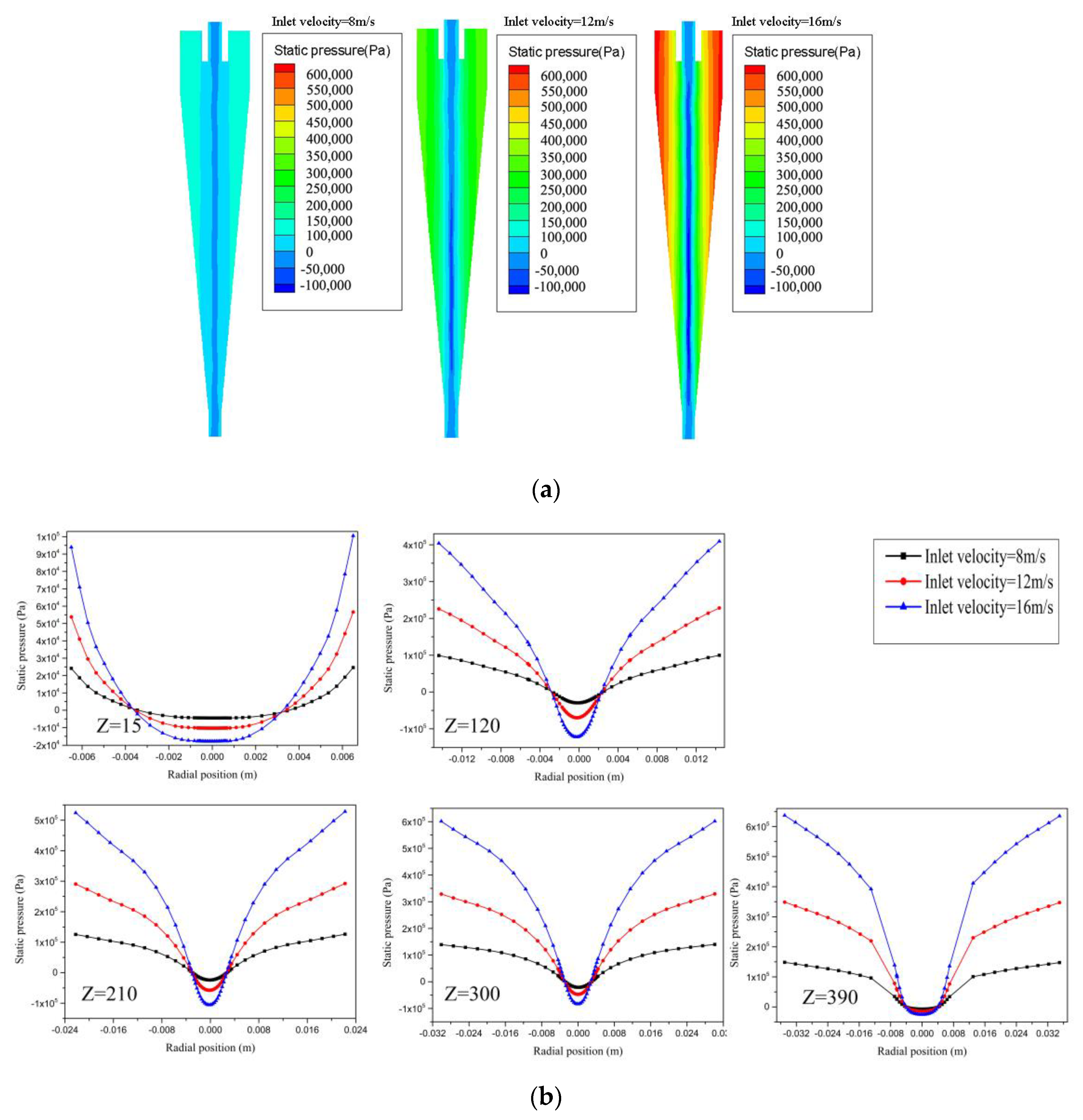


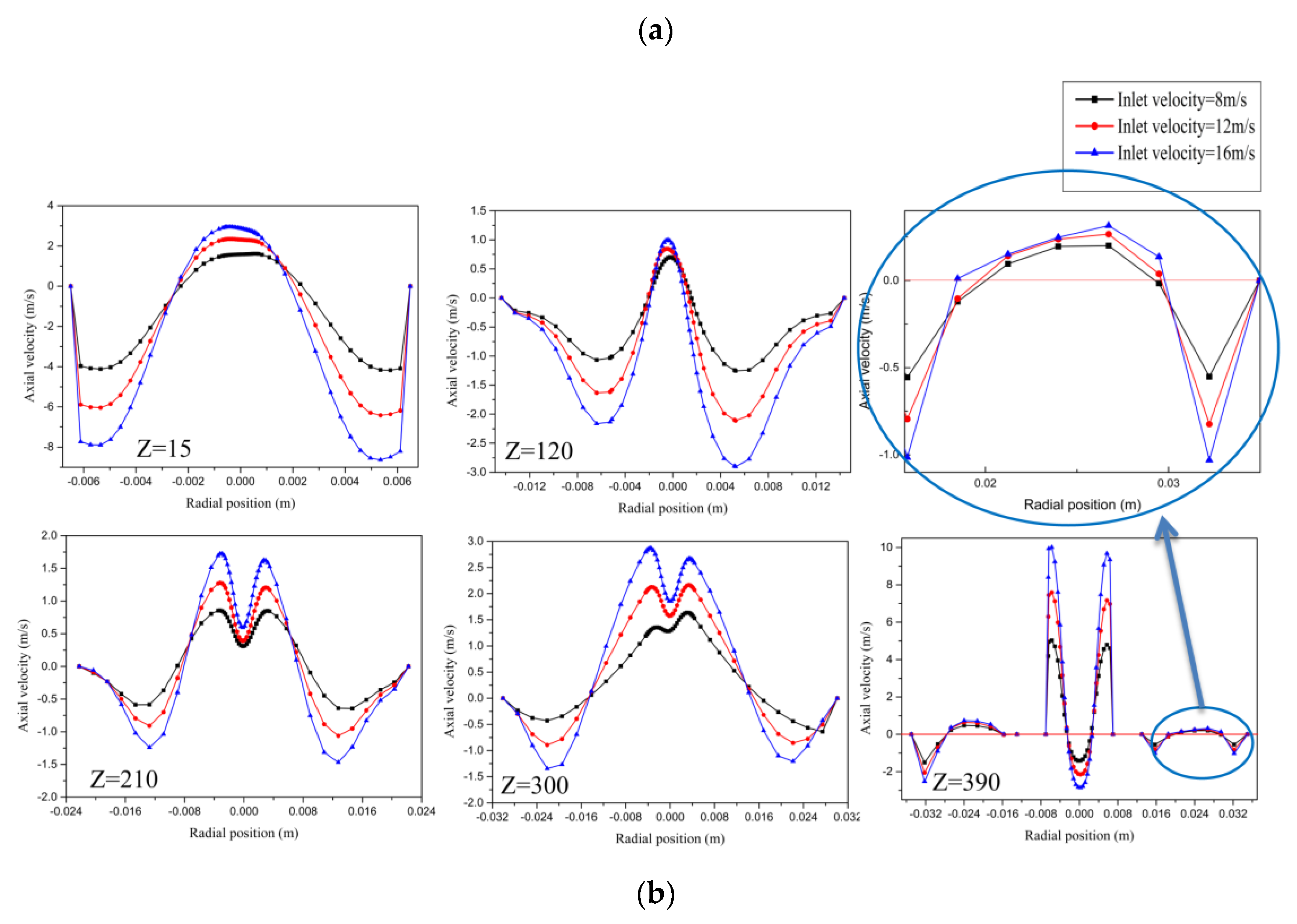



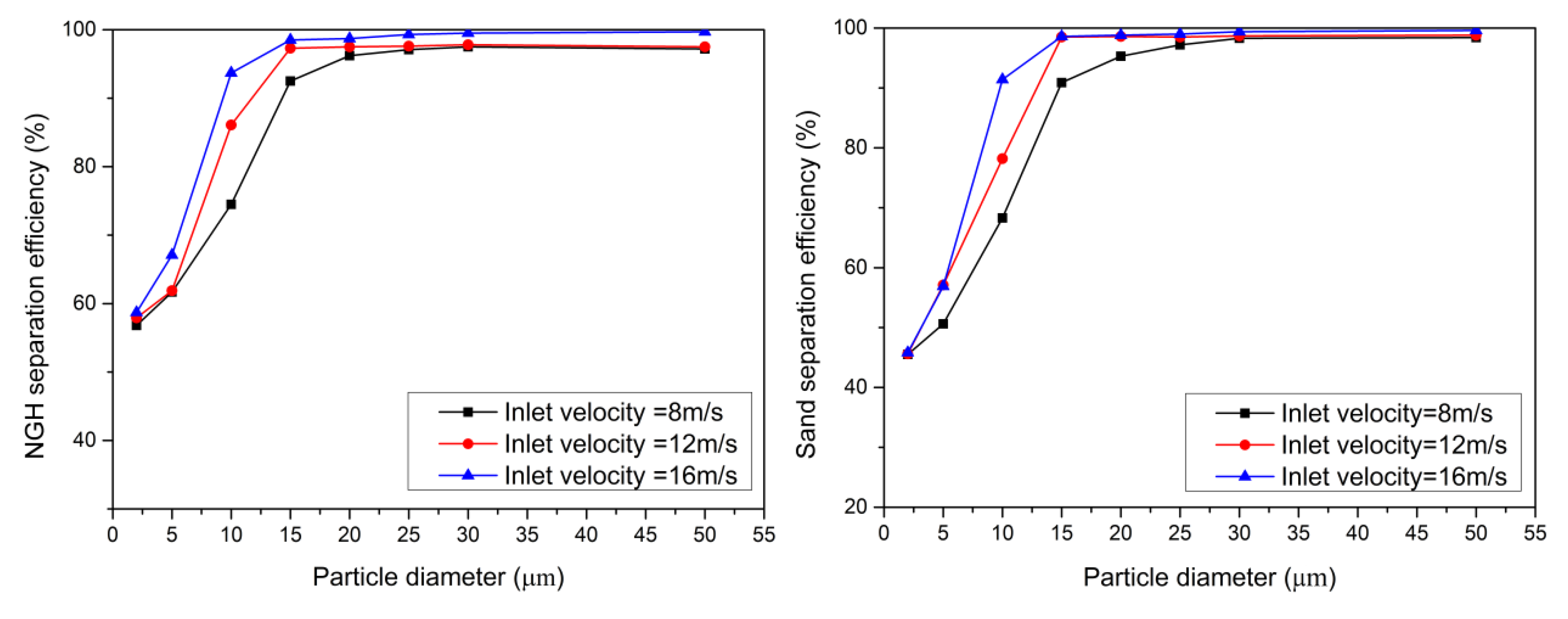
| Names | Size |
|---|---|
| Dominant diameter D, mm | 70 |
| Inlet height a, mm | 18 |
| Inlet width b, mm | 6 |
| Vortex finder diameter d0, mm | 14 |
| Vortex finder length L0, mm | 50 |
| Cylindrical length L, mm | 60 |
| Cone angle, ° | 10 |
| Spigot diameter ds, mm | 13 |
| Mesh Sizes | Maximum Static Pressure (MPa) |
|---|---|
| 100,000 | 0.161555 |
| 200,000 | 0.293760 |
| 300,000 | 0.389087 |
| 400,000 | 0.389125 |
| 500,000 | 0.389053 |
| Parameter | Value |
|---|---|
| Inlet velocity, m/s (Inlet flow rates, m3/h) | 8, 12, 16 (3.11, 4.67, 6.22) |
| Particle diameter, μm | 2, 10, 30 |
| Outlet pressure, MPa | 0 |
| Operating condition: temperature, °C, and pressure, MPa | 13 and 14 |
| Media | Density, kg/m3 | Viscosity, kg/m/s | Volume Fraction, % |
|---|---|---|---|
| Seawater | 1025 | 0.0017 | 75 |
| Sand | 2600 | - | 15 |
| NGH | 910 | - | 10 |
© 2019 by the authors. Licensee MDPI, Basel, Switzerland. This article is an open access article distributed under the terms and conditions of the Creative Commons Attribution (CC BY) license (http://creativecommons.org/licenses/by/4.0/).
Share and Cite
Qiu, S.; Wang, G.; Wang, L.; Fang, X. A Downhole Hydrocyclone for the Recovery of Natural Gas Hydrates and Desanding: The CFD Simulation of the Flow Field and Separation Performance. Energies 2019, 12, 3257. https://doi.org/10.3390/en12173257
Qiu S, Wang G, Wang L, Fang X. A Downhole Hydrocyclone for the Recovery of Natural Gas Hydrates and Desanding: The CFD Simulation of the Flow Field and Separation Performance. Energies. 2019; 12(17):3257. https://doi.org/10.3390/en12173257
Chicago/Turabian StyleQiu, Shunzuo, Guorong Wang, Leizhen Wang, and Xing Fang. 2019. "A Downhole Hydrocyclone for the Recovery of Natural Gas Hydrates and Desanding: The CFD Simulation of the Flow Field and Separation Performance" Energies 12, no. 17: 3257. https://doi.org/10.3390/en12173257
APA StyleQiu, S., Wang, G., Wang, L., & Fang, X. (2019). A Downhole Hydrocyclone for the Recovery of Natural Gas Hydrates and Desanding: The CFD Simulation of the Flow Field and Separation Performance. Energies, 12(17), 3257. https://doi.org/10.3390/en12173257





